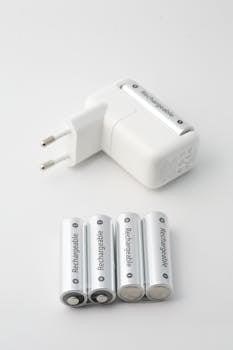This manual provides a comprehensive guide for installing, operating, and maintaining Hayward variable speed pumps, ensuring safe and efficient operation. It covers installation, programming, and energy-efficient features, designed for both installers and end-users to maximize performance and safety.
1.1 Overview of Variable Speed Pumps
Variable speed pumps are advanced pool pumps designed to adjust their speed based on specific tasks, optimizing energy use and performance. Unlike traditional single-speed pumps, these models offer multiple programmable speeds, allowing customization for filtration, cleaning, and other pool functions. Hayward variable speed pumps, such as the EcoStar and TriStar series, feature fully electronic drives, enabling precise control and silent operation. They are equipped with intuitive interfaces for easy programming and adaptability to varying pool demands. By reducing unnecessary high-speed operation, these pumps significantly lower energy consumption and operational noise. Their versatility and efficiency make them ideal for modern pool systems, catering to diverse pool sizes and user preferences while ensuring long-term reliability and cost savings.
1.2 Importance of the Manual
This manual is essential for the safe and effective use of Hayward variable speed pumps. It provides detailed instructions for installation, operation, and maintenance, ensuring compliance with safety standards and optimal performance. By following the manual, users can avoid potential hazards, such as electrical risks or improper handling, which could lead to serious injury or equipment damage. The manual also serves as a legal and warranty requirement, as failure to adhere to its guidelines may void the product’s warranty or result in liability issues. It is crucial for installers to share this information with end-users to ensure proper usage and maximize the pump’s energy efficiency and longevity. Adhering to the manual’s instructions is vital for both safety and performance.

1.3 Benefits of Variable Speed Technology
Variable speed technology offers significant advantages, including enhanced energy efficiency, reduced operational noise, and extended equipment lifespan. By adjusting pump speed to meet specific demands, users can save up to 90% on energy costs compared to traditional single-speed pumps. This technology also allows for customizable speed settings, enabling precise control over water flow for various pool functions. Additionally, variable speed pumps are EPA Energy Star certified, recognizing their energy-efficient performance. The reduced noise levels during operation provide a quieter pool environment. Overall, variable speed technology combines cost savings, flexibility, and environmental benefits, making it a superior choice for modern pool systems. These benefits ensure optimal performance while minimizing energy consumption and operational noise.

Safety Precautions and Warnings
Always follow safety guidelines to prevent injury. Replace damaged power cords only by authorized personnel. Ensure proper installation and operation to avoid hazards. Adhere to electrical safety standards.

2.1 General Safety Warnings
Read this manual thoroughly before installation or operation. Failure to follow instructions may result in serious injury or damage. Ensure the pump is installed and maintained by qualified personnel. Never modify the pump or its components, as this voids warranties and poses safety risks. Keep children and unauthorized individuals away from the pump. Avoid exposing electrical components to water or moisture. Do not operate the pump if the power cord is damaged; only authorized personnel should replace it. Always follow local electrical and safety codes. Proper grounding is essential to prevent electrical hazards. Use the pump solely for its intended purpose. Failure to adhere to these warnings may lead to electrical shock, injury, or equipment damage.
2.2 Electrical Safety Considerations
Ensure the pump is connected to a G.F.C.I. (Ground Fault Circuit Interrupter) protected circuit to prevent electrical shock. Never operate the pump in areas with flammable gases or vapors. The power cord must only be replaced by the manufacturer or a qualified technician if damaged. Proper grounding is essential to avoid electrical hazards. Always disconnect power before servicing or maintaining the pump. Use the pump solely for its intended purpose, as specified in this manual. Electrical components must not be exposed to water or moisture. Follow all local and national electrical codes during installation. Failure to comply with these guidelines may result in electrical shock, injury, or equipment damage. Always ensure the pump and its components are properly de-energized before performing any maintenance or repairs.
2.3 Handling and Storage Precautions
Handle the pump with care to avoid physical stress or damage. Always use the original packaging for storage or transportation to prevent scratches or dents. Store the pump in a clean, dry, and well-ventilated area, away from direct sunlight and extreme temperatures. Avoid exposing the pump to flammable materials or chemicals. Ensure the pump is completely dry before storing it for extended periods. When transporting, keep the pump upright to prevent internal component damage. Never store the pump in a location accessible to children or unauthorized personnel. For long-term storage, disconnect the power cord and cover the pump to protect it from dust. Follow all manufacturer guidelines for handling and storage to maintain the pump’s performance and longevity.

Installation Requirements
Ensure proper site preparation, electrical connections, and secure mounting; Follow manual guidelines for optimal performance and safety. Correct installation ensures efficient operation and longevity of the pump.

3.1 Site Preparation and Location
Proper site preparation and location are critical for optimal pump performance. Ensure the pump is installed on a level, stable surface, away from debris and water accumulation. The location should provide easy access for maintenance and programming. For Hayward models like EcoStar and TriStar, ensure the area is clear of obstructions to allow proper airflow and cooling. The pump should be positioned near a power source, adhering to electrical safety guidelines. Drainage considerations are essential to prevent water damage or electrical hazards. Follow the manual’s specific instructions for placement to ensure compliance with safety standards and energy efficiency. Proper installation ensures longevity and reliable operation of the variable speed pump.
3.2 Electrical Installation Guidelines
Electrical installation must adhere to local codes and safety standards. Use a GFCI-protected circuit for Hayward variable speed pumps, especially for models like the XE series. Ensure the power supply matches the pump’s voltage and horsepower requirements. Hire a licensed electrician if unsure. Avoid modifying the power cord, as this could void the warranty or pose safety risks. Keep the cord away from water and extreme temperatures. For models like EcoStar and TriStar, follow specific wiring instructions in the manual to ensure proper communication with control systems. Always disconnect power before servicing. Proper electrical installation ensures safe, efficient, and reliable operation of the pump, preventing potential hazards and extending its lifespan.
3.3 Mounting and Plumbing Instructions
Mount the pump on a level, stable surface to ensure proper operation. Use Hayward-recommended adapters for secure installation. Plumbing connections must be correctly sized to match the pump’s inlet and outlet ports. Avoid over-tightening fittings to prevent damage. Ensure all pipes are clear of debris before connecting. Use flexible piping to reduce vibration and noise. Secure the pump firmly to prevent movement during operation. Follow local plumbing codes and regulations. Proper mounting and plumbing ensure efficient performance, minimize noise, and prevent potential leaks or damage. Always refer to the specific model’s instructions for any unique requirements, such as additional supports or adapters. Correct installation ensures optimal functionality and longevity of the pump.
Operating the Variable Speed Pump
Operate the pump by using the control interface to adjust speeds and monitor performance; Start and stop the pump as needed, ensuring smooth and efficient operation always.
4.1 Understanding the Control Interface
The control interface of the Hayward variable speed pump is designed to be user-friendly, allowing easy navigation and adjustment of settings. It typically features a display screen and buttons for cycling through options. The interface enables users to monitor the pump’s speed, set custom programs, and adjust intervals. The buttons are used to scroll through available speeds, with options to save preferred settings for future use. Additionally, the interface may include indicators for system status, errors, or maintenance alerts. Understanding the control interface is crucial for optimizing pump performance and ensuring efficient operation. Always refer to the manual for detailed guidance on utilizing the interface effectively and safely.
4.2 Starting and Stopping the Pump
Starting and stopping the Hayward variable speed pump is a straightforward process. To start, ensure the pump is properly connected to a power source and all electrical connections are secure. Press the control button to power on the pump and select the desired speed or program. The pump will begin operating at the chosen setting. To stop the pump, press and hold the control button until it powers down. Always ensure the pump is stopped before performing maintenance or during emergencies. Refer to the manual for specific instructions, as some models may have additional steps or safety features. Proper operation ensures longevity and safety of the pump. Always follow the manufacturer’s guidelines for starting and stopping procedures.

Programming the Variable Speed Pump

Programming involves setting speed programs, adjusting intervals, and using the Hayward Unique Address (HUA) for customization. Press the button to cycle through speeds and hold to save settings.
5.1 Setting Up Speed Programs
Setting up speed programs on your Hayward variable speed pump involves selecting predefined or custom speed settings to optimize performance. Use the control interface to navigate through available speeds, typically ranging from low to high. Press the button to cycle through speeds and hold it to save your selection to a specific interval; The pump allows multiple speed programs, enabling tailored operation for different pool functions, such as filtration, cleaning, or water features. Ensure the Hayward Unique Address (HUA) is correctly set for proper communication with other pool devices. Refer to the manual for detailed step-by-step instructions to customize your speed programs effectively.
5.2 Adjusting Speed Intervals
Adjusting speed intervals on your Hayward variable speed pump allows you to customize operation for specific tasks. Use the control interface to modify the duration and speed of each interval. Press the button to cycle through available speeds, then hold it to save the setting to the desired interval. The pump typically offers multiple intervals, enabling you to set different speeds for filtration, cleaning, or water features. For advanced control, use the Hayward OmniLogic system to program intervals remotely. Ensure the Hayward Unique Address (HUA) is correctly set for proper communication. Refer to the manual for detailed instructions on adjusting intervals and troubleshooting common issues. Proper adjustment ensures optimal performance and energy efficiency.
5.3 Using the Hayward Unique Address (HUA)
The Hayward Unique Address (HUA) is a unique identifier assigned to each variable speed pump, ensuring proper communication within Hayward pool automation systems. To use the HUA, locate it on the pump’s label or in the manual. When programming the pump through Hayward’s OmniLogic system, select the HUA that matches your pump’s identifier. This ensures the system recognizes and controls the pump correctly. The HUA is essential for integrating the pump with other Hayward devices, such as controllers or remotes. Always verify the HUA during setup to avoid communication errors. This feature simplifies system synchronization and ensures seamless operation of your pool equipment. Refer to the manual for detailed steps on HUA configuration and troubleshooting.

Maintenance and Troubleshooting
Regular maintenance ensures optimal performance. Clean the pump basket, inspect for damage, and monitor motor performance. Troubleshoot common issues like low flow or noise promptly. Refer to the manual for detailed guidance on resolving operational problems and scheduling routine care.
6.1 Routine Maintenance Tasks
Regular maintenance is essential to ensure the Hayward variable speed pump operates efficiently. Start by cleaning the pump basket and strainer to prevent debris buildup. Inspect the motor and electrical connections for wear or damage. Lubricate moving parts as recommended. Check the impeller for blockages and ensure proper alignment. Monitor the pump’s performance and adjust settings if necessary. Replace worn or damaged seals to prevent leaks. Schedule periodic professional inspections to address potential issues early. Always refer to the manual for specific maintenance schedules and procedures tailored to your model. Proper care extends the pump’s lifespan and maintains energy efficiency, ensuring reliable operation year-round.
6.2 Common Issues and Solutions
Common issues with Hayward variable speed pumps include error codes, low flow rates, or motor noise. For error codes, refer to the manual or reset the pump. Low flow rates may result from clogged filters or improper sizing; clean filters and ensure correct installation. Motor noise could indicate misalignment or worn bearings; check alignment and replace parts as needed. If the pump doesn’t start, verify electrical connections and ensure the circuit is not overloaded. For persistent issues, consult the troubleshooting guide or contact Hayward support. Regular maintenance, such as cleaning and inspecting components, can prevent many problems. Always follow the manufacturer’s instructions for repairs to avoid further damage or safety risks.
Energy Efficiency and Certification
Hayward variable speed pumps are EPA Energy Star certified, meeting DOE standards for energy efficiency. They reduce energy consumption and operational costs while maintaining high performance.
7.1 EPA Energy Star Certification
The Hayward variable speed pumps are EPA Energy Star certified, ensuring they meet rigorous energy efficiency standards set by the U.S. Environmental Protection Agency. This certification recognizes products that reduce energy consumption and lower operational costs without compromising performance. Hayward’s EcoStar and TriStar models, for instance, are designed to optimize energy use while maintaining high-quality operation. By achieving Energy Star certification, Hayward demonstrates its commitment to environmental sustainability and cost-saving solutions for pool owners. This certification also assures users that these pumps meet the latest Department of Energy (DOE) requirements, making them a reliable choice for energy-conscious consumers. The Energy Star label is a trusted symbol of energy efficiency and environmental stewardship.
Hayward Variable Speed Pump Models
Hayward offers a range of variable speed pump models, including EcoStar, TriStar, and Super Pump VS, designed for energy efficiency, durability, and superior performance in various pool applications.
8.1 Overview of Popular Models
Hayward offers several popular variable speed pump models, each designed for specific pool needs. The EcoStar SP3400VSP is a high-efficiency model with three programmable speeds, ideal for mid-size pools. The TriStar VS 900, a 1.85hp pump, is suited for medium to high-capacity pools, offering silent operation and energy savings. The Super Pump VS is known for its user-friendly interface and adjustable RPM settings, making it versatile for various pool applications. These models are engineered to provide reliable performance, energy efficiency, and durability, catering to different pool sizes and user preferences. Each model is backed by Hayward’s reputation for quality and innovation in pool equipment.

8.2 EcoStar and TriStar Series
The EcoStar and TriStar series are among Hayward’s most advanced variable speed pump lines, designed for energy efficiency and performance. The EcoStar SP3400VSP is a high-efficiency model with three programmable speeds, ideal for mid-size pools, offering quiet operation and significant energy savings. The TriStar VS 900, a 1.85hp pump, is engineered for medium to high-capacity pools, featuring a robust design and silent operation. Both series are ENERGY STAR certified, ensuring compliance with energy efficiency standards. These pumps are known for their durability, user-friendly interfaces, and adaptability to various pool applications. Hayward’s EcoStar and TriStar series are popular choices for pool owners seeking reliable, high-performance, and energy-efficient solutions.
In conclusion, the Hayward Variable Speed Pump Manual serves as an essential resource for installers and pool owners, providing detailed guidance on installation, operation, and maintenance. By following the manual’s instructions, users can ensure optimal performance, energy efficiency, and safety. Hayward’s variable speed pumps, including the EcoStar and TriStar series, are designed to deliver exceptional reliability and cost savings. The manual emphasizes the importance of adhering to safety precautions and programming guidelines to maximize the pump’s efficiency. With its comprehensive coverage, this manual empowers users to make the most of their Hayward variable speed pump, ensuring a safe and energy-efficient pool experience. By referring to this guide, users can troubleshoot common issues and maintain their pump’s longevity effectively.






































































